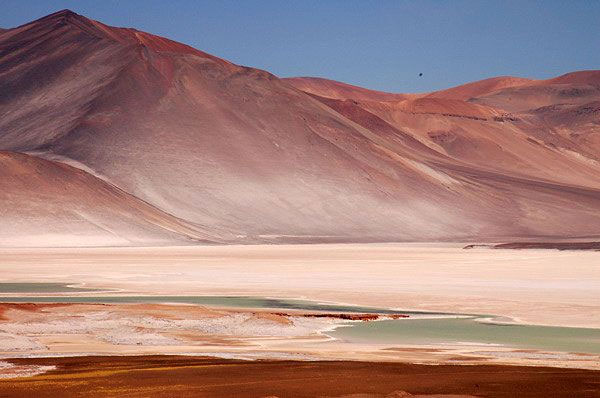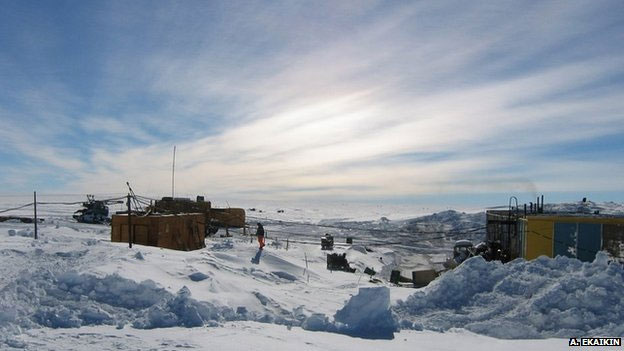7 'Mars' lands on Earth
7 areas below converge to the harshest weather conditions on Mars. Therefore, scientists decided to use these 7 sites to test science technologies before putting them into space.
Atacama Desert, Chile

Atacama Desert in Chile is located on a 966km plateau in South America and is one of the driest areas on Earth.
In 2004, scientists from the US Aeronautics Agency (NASA) spent four weeks studying the Atacama desert to find out if life could exist on Mars.
Because the Atacama desert is located in the shoreline of the Chilean coast, the climate here is extremely dry, along with the combination of cold offshore currents that have caused frost particles to break down before reaching the surface. desert.
Some weather stations in the desert have never recorded any rain. So in 2011, the Atacama desert became the focus of global news when an 80cm snowfall hit the area. This is the biggest snowfall in 20 years.
Lake Vostok, Antarctica

When a group of Russian scientists drilled exploration of hard waters on Lake Vostok located at a depth of 3 km in the Antarctic ice sheet in 2012, the world scientists focused their attention on the hope that the expedition would come There is evidence of how organisms survive in a cold environment on Mars - where the temperature is about -60 degrees Celsius.
14 - 34 million years ago, an ice sheet covering Vostok Lake made this lake completely isolated from the outside world.
Scientists believe the huge freshwater reserves in the lake could be home to cold-hardened creatures and live in the dark under thick ice for millions of years. They hope to find similar creatures on Mars.
Volcano Pico de Orizaba, Mexico

The trees around Pico de Orizaba in Mexico are considered one of the tallest trees in the world. Scientists are currently studying how life forms in a place with such steep and cold terrain. Once the answer to the question is answered, the scientists completely believe that Mars is a living planet.
The Pico de Orizaba volcano, located at an elevation of 5,675m - is recognized as one of the world's highest elevations of life support, erupted for the last time in 1846. 4,000m.
For years researchers have repeatedly climbed into the volcanic region to find out how life originated in this harsh climate on Mars.
Ellesmere Island, Canada

Ellesmere Island is a large area north of the Earth that is considered an ideal area for studying Mars.
Ellesmere Island is the 10th largest island on Earth and the third largest in Canada. In it, Grise Fiord - the largest city on the island is home to 141 people. Ellesmere Island is located on Canada's Nunavut territory, 1,110km from Antarctica.
Located in a cold Arctic area, scientists conducted exploration drilling tests at Ellesmere as a preparation for the journey to discover water on Mars.
In 2006, NASA engineers spent two weeks drilling and drilling a 1.8-meter-wide drill hole using a power source just like a 60-watt light bulb. This mobile drill device can help astronauts easily transport in space.
In the future, the drilling equipment will be drilled by astronauts on Mars' ice caps for life and water.
Devon Island, Canada

Devon Island is the largest uninhabited island in the world. The climate here is completely dry and cold, identical to the weather conditions on Mars. The highlight of the island's attraction is the appearance of a 24-kilometer hole.
Haughton wormhole formed 23 million years ago is an ideal place for scientists since 1997. Recently, scientists have made a prototype deep bore for the above exploration drilling mission. Mars in an area located in the Haughton hole.
Dry valley, Antarctica

In 2009, NASA scientists tested thick ice exploratory drilling in the McMurdo dry valley to demonstrate the effectiveness of drilling equipment in the future mission to the north pole on Mars.
The scientific world that recognizes Mars's north pole may be a place to support life. This area has received more sunlight than any other area on the Red planet several million years ago. However, the orbiting planet of this planet along with the tilting axis of orbit changed the amount of sunlight that reached this area.
In theory, a place with lots of sunlight means the appearance of water and life.
Death Valley, California

NASA tested all the functions of the Curiosity explorer ship - the ship is about to land on the surface of Mars in early August, right in Death Valley.
For decades, researchers have focused on ancient rock layers right on the Death Valley desert to learn about the history of the Earth. In addition, this hot desert also helps scientists experiment with generations of robots serving Mars research.
Curiosity is part of NASA's $ 2.5 billion Mars Science Experiment program. In particular, the Curiosity vessel was launched into space in November last year. The ship is expected to land in the Gale pit area on August 5. The goal of this mission is to find out if the Gale pit is the home of bacteria and whether life exists here.
However, Death Valley is not really a magnificent replica of Mars because the temperature of this desert is too hot. Death Valley holds the title of hottest area in the Western hemisphere when reaching 56.7 degrees C.
Death Valley is also home to ancient stromatolite rocks in the western part of North America. In it, many stones are identified to be 1 billion years old.
Stromatolite rock is an ancient sedimentary rock structure with a round or cylindrical top shape formed in layers of shallow water through long-term geological transformation. If scientists find this type of stone on the Red planet, they have a good chance of believing that the bacteria are settled here.
- 5 magical lands in world famous legend
- Mars and the earth come together
- How to transform Mars into a Second Earth
- Did the ocean on Mars get into the rock?
- Mars will approach Earth on May 30
- The risk of spreading bacteria from Earth to Mars
- How to bring Martian stones to Earth?
- How is Mars different from Earth?
- Earth bacteria travel to Mars
- Mars used to be 'green planet' like Earth
- Rock from Mars falls to earth
- Should Mars be an independent planet or Earth's colony?
 Van Allen's belt and evidence that the Apollo 11 mission to the Moon was myth
Van Allen's belt and evidence that the Apollo 11 mission to the Moon was myth The levels of civilization in the universe (Kardashev scale)
The levels of civilization in the universe (Kardashev scale) Today Mars, the sun and the Earth are aligned
Today Mars, the sun and the Earth are aligned The Amazon owner announced a secret plan to build a space base for thousands of people
The Amazon owner announced a secret plan to build a space base for thousands of people